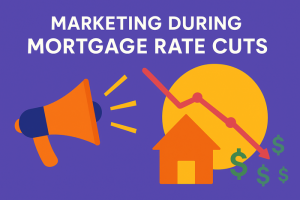Summary
This article discusses how mortgage professionals can adapt and thrive in a down market. Learn strategies to manage your business and continue generating leads during economic downturns. By the end, you’ll know how to adjust your approach and remain competitive.
Feeling your loan pipeline and income being squeezed by the new direction of the market? Worried that it’s going to happen, even if you’re still enjoying plenty of closings now? Check out these quick tips for optimizing a lean mortgage business that can be even more profitable, even in a down market. Check out everything you need to do in when the market slows here.
The New Mortgage Landscape

The US housing and mortgage market has definitely taken on a different trajectory since the summer of 2018. Lack of affordability, rising interest rates, tight underwriting and a new recession are all making it likely that mortgage companies will face even more challenges in 2019.
While it clearly appears counter intuitive, the Fed only appears likely to keep raising interest rates over the next year. Freddie Mac predicts average 30 year mortgage rates will move dangerously close to 6% by 2020.
The National Association of Realtors recently substantially reduced their estimate of total homes sales for last year. That followed the Mortgage Bankers Association’s loan origination forecast in October. Meaning borrowers and loan applications could be even fewer than previously projected.
At the beginning of Q4 2018, the MBA forecast that refinance volume would fall by 12.4% in 2019 due to higher interest rates. Those rates are already at a new 7.5 year high. The highest since the bottom of the previous crisis.
Mortgage professionals were hopeful that new purchase loan originations and higher home prices would limit the loss in dollars loaned in 2019 to a modest decline. With a target total of $1.63T.
New data showing just how few millennials actually have any savings for a down payment, coupled with rising inventory and listing prices being slashed, could result in even few loans being made over the next two years. That’s after originations have already dropped by around $500B per year from 2012 and 2016. A new recession and uptick in unemployment could make the outlook even more grim.
Any mortgage industry professionals who have been around since before 2008 knows that soft landings are rare at best, and markets normally far over correct before improving.
That leaves loan officers, brokers and lenders with one big question. How do they get leaner and stay profitable with far fewer loans to be made?
Know Your Math

How much revenue do you need to bring in to cover the basics each month? Including taxes? What will it take in closings, loan applications, new mortgage leads and marketing to get there?
What is your profit margin? What’s the minimum you need to make per loan to ensure a strong profit margin and enough surplus cash to continue growing marketing efforts and invest in the new technology you’ll need to stand out?
Is there a need to target different types of borrowers or loans in order to increase profit margins? Remember that higher loan volumes don’t always mean more profit. The opposite can be true. What’s most important is how much you get to keep.
Low Overhead

It’s the overhead that kills most loan officer careers and mortgage offices. Fortunately, the industry is operating far leaner than it was 12 to 15 years ago. Yet, many can do better.
Do you need to scrap underutilized square footage? Are you fully paperless and using online storage as much as possible? Are you using remote and on-demand workers?
If you must have physical office space, what shared office space options are there? Can you implant yourself or team members in other relevant offices or coworking spaces? Can you sublease some of your space?
Overhead may also apply to your own bills as a loan officer. Have you amassed a lot of new debt? What happens when the rates on that go up? Have you accumulated countless recurring charges on your credit cards for subscriptions you no longer use? That’s all money that can be put into marketing and more efficient technology instead.
Crush it on Conversions

Mortgage professionals and lending companies don’t just need to do more mass marketing at this phase of the cycle. They need more efficient and more profitable marketing.
Watch those conversion rates. Could new POS software be just what you need to increase conversions and generate higher returns on your marketing budget? Could hiring a conversion expert for an hour or two to tweak your copy make tens of thousands of dollars of difference to your revenue each month?
Automation & Time Management

It’s times like this in which time management really matters.
What tasks are you wasting your time on that should be automated? So much of the most time draining customer service functions and prospecting efforts brokers and LOs do can and should be automated. Think AI phone systems, bulk text messaging, email autoresponders, and mobile apps and online dashboards for updating everyone on the status of loan applications.
Here’s the bottom line. If you want to make just $1M this year, you need to be making over $400 an hour. You don’t make $400 an hour cutting your own grass, washing your own car, going to the grocery store, in most meetings, editing your own website, or talking to unqualified prospects. The only way you are going to hit your revenue and income goals is by focusing all of your working time on exclusively speaking to the most qualified borrowers, and negotiating strategic referral deals. Delegate or automate everything else.
Key Takeaways
- Adapt to Market Shifts
Flexibility is key to surviving and thriving in a down market. Adjusting your strategy helps you maintain business stability.
- Focus on Building Relationships
Strengthening relationships with clients and partners can provide long-term stability even in challenging times.
- Stay Focused on Lead Generation
A strong focus on consistent lead generation can ensure business continuity despite market challenges.
Commonly Asked Questions
- How can mortgage professionals adapt to a down market?
By adjusting strategies and focusing on relationship-building and consistent lead generation.
- Why is relationship-building important in tough markets?
Strong relationships help ensure long-term business stability even when the market is challenging.
- What should mortgage professionals focus on during a down market?
Focus on lead generation, client relationships, and adapting to market shifts.
- What is the key takeaway from this article?
Mortgage professionals can thrive in a down market by adapting strategies, focusing on relationships, and continuing lead generation.





